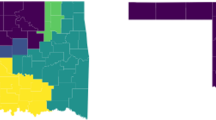Abstract
Every 10 years, United States Congressional Districts must be redesigned in response to a national census. While the size of practical political districting problems is typically too large for exact optimization approaches, heuristics such as local search can help stakeholders quickly identify good (but suboptimal) plans that suit their objectives. However, enforcing a district contiguity constraint during local search can require significant computation; tools that can reduce contiguity-based computations in large practical districting problems are needed. This paper applies the geo-graph framework to the creation of United States Congressional Districts from census blocks in four states—Arizona, Massachusetts, New Mexico, and New York—and finds that (a) geo-graph contiguity assessment algorithms reduce the average number of edges visited during contiguity assessments by at least three orders of magnitude in every problem instance when compared with simple graph search, and (b) the assumptions of the geo-graph model are easily adapted to the sometimes-irregular census block geography with only superficial impact on the solution space. These results show that the geo-graph model and its associated contiguity algorithms provide a powerful constraint assessment tool to political districting stakeholders.






Similar content being viewed by others
References
Altman, M.: Is automation the answer? The computational complexity of automated redistricting. Rutgers Comput. Technol. Law J. 23(1), 81–142 (1997)
Bozkaya, B., Erkut, E., Laporte, G.: A tabu search heuristic and adaptive memory procedure for political districting. Eur. J. Oper. Res. 144(1), 12–26 (2003)
Burnett, K.D.: Congressional apportionment. http://www.census.gov/prod/cen2010/briefs/c2010br-08.pdf (2011). Accessed 29 Dec 2011
Butler, D., Cain, B.E.: Congressional Redistricting: Comparative and Theoretical Perspectives. MacMillan Publishing Company, New York (1992)
D’Amico, S.J., Wang, S.J., Batta, R., Rump, C.M.: A simulated annealing approach to police district design. Comput. Oper. Res. 29, 667–684 (2002)
di Cortona, P.G., Manzi, C., Pennisi, A., Ricca, F., Simeone, B.: Evaluation and Optimization of Electoral Systems. Society for Industrial and Applied Mathematics, Philadelphia (1999)
Drexl, A., Haase, K.: Fast approximation methods for sales force deployment. Manag. Sci. 45(10), 1307–1323 (1999)
Horowitz, E., Sahni, S.: Fundamentals of Computer Algorithms. Computer Science Press, Rockville (1978)
Kalcsics, J., Nickel, S., Schröder, M.: Towards a unified territorial design approach—applications, algorithms and GIS integration. TOP 13(1), 1–56 (2005)
Kernighan, B.W., Lin, S.: An efficient heuristic procedure for partitioning graphs. Bell Syst. Tech. J. 49(1), 291–307 (1970)
King, D.M.: Graph theory models and algorithms for political districting: an approach to inform public policy. Ph.D. thesis, University of Illinois at Urbana-Champaign (2012)
King, D.M., Jacobson, S.H., Sewell, E.C.: Efficient geo-graph contiguity and hole algorithms for geographic zoning and dynamic plane graph partitioning. Math. Program. Ser. A 149(1–2), 425–457 (2015)
King, D.M., Jacobson, S.H., Sewell, E.C., Cho, W.K.T.: Geo-graphs: an efficient model for enforcing contiguity and hole constraints in planar graph partitioning. Oper. Res. 60(5), 1213–1228 (2012)
Mehrotra, A., Johnson, E.L., Nemhauser, G.L.: An optimization based heuristic for political districting. Manag. Sci. 44(8), 1100–1114 (1998)
Missouri Census Data Center: MABLE/Geocorr2010: Geographic correspondence engine with census 2010 geography. http://mcdc1.missouri.edu/MableGeocorr/geocorr2010.html (2011). Accessed 29 Dec 2011
Public Mapping Project: About the data. http://www.publicmapping.org/resources/data (2011). Accessed 29 Dec 2011
Ricca, F.: A multicriteria districting heuristic for the aggregation of zones and its use in computing origin-destination matrices. INFOR 42(1), 61–77 (2004)
Ricca, F., Scozzari, A., Simeone, B.: Weighted Voronoi region algorithms for political districting. Math. Comput. Model. 48(9), 1468–1477 (2008)
Ricca, F., Scozzari, A., Simeone, B.: Political districting: from classical models to recent approaches. 4OR 9(3), 223–254 (2011)
Ricca, F., Simeone, B.: Local search algorithms for political districting. Eur. J. Oper. Res. 189, 1409–1426 (2008)
Schwartzberg, J.E.: Reapportionment, gerrymanders, and the notion of compactness. Minn. Law Rev. 50, 443–452 (1965)
Shirabe, T.: A model of contiguity for spatial unit allocation. Geogr. Anal. 37(1), 2–16 (2005)
Shirabe, T.: Districting modeling with exact contiguity constraints. Environ. Plan. B Plan. Des. 36(6), 1053–1066 (2009)
Tarjan, R.: Depth-first search and linear graph algorithms. SIAM J. Comput. 1(2), 146–160 (1972)
Theobald, D.M.: Understanding topology and shapefiles. ArcUser. http://www.esri.com/news/arcuser/0401/topo.html (2001). Accessed 12 May 2011, April–June
United States Census Bureau: 2010 Census TIGER/Line Shapefiles. http://www.census.gov/geo/www/tiger/tgrshp2010/tgrshp2010.html (2011). Accessed 29 Dec 2011
United States Census Bureau: Tallies of census blocks by state or state equivalent. http://www.census.gov/geo/www/2010census/census_block_tally.html (2011). Accessed 27 May 2011
Webster, G.R.: Reflections on current criteria to evaluate redistricting plans. Polit. Geogr. 32, 3–14 (2013)
Yamada, T.: A mini-max spanning forest approach to the political districting problem. Int. J. Syst. Sci. 40(5), 471–477 (2009)
Acknowledgements
The computational work was conducted with support from the Simulation and Optimization Laboratory at the University of Illinois. This research was supported in part by the National Science Foundation [IIS-0827540]. The second author was supported in part by the Air Force Office of Scientific Research [FA9550-10-1-0387, FA9550-15-1-0100]. The views expressed in this paper are those of the authors and do not reflect the official policy or position of the United States Air Force, the National Science Foundation, or the United States Government. This work originally appeared in the Ph.D. dissertation of the first author [11].
Author information
Authors and Affiliations
Corresponding author
Additional information
This research was supported in part by the National Science Foundation [IIS-0827540]. The second author was supported in part by the Air Force Office of Scientific Research [FA9550-10-1-0387, FA9550-15-1-0100].
Rights and permissions
About this article
Cite this article
King, D.M., Jacobson, S.H. & Sewell, E.C. The geo-graph in practice: creating United States Congressional Districts from census blocks. Comput Optim Appl 69, 25–49 (2018). https://doi.org/10.1007/s10589-017-9936-3
Received:
Published:
Issue Date:
DOI: https://doi.org/10.1007/s10589-017-9936-3




